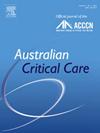Extracorporeal membrane oxygenation cannula dressing and securement practices: A point prevalence study
IF 2.7
3区 医学
Q2 CRITICAL CARE MEDICINE
引用次数: 0
Abstract
Background
Effective securement of extracorporeal membrane oxygenation (ECMO) cannulae, both at the insertion site and along the length of circuit tubing, may reduce the risk of cannula migration, dislodgement, and infection, all of which can lead to adverse patient outcomes. Despite this, there are no evidence-based clinical practice guidelines to inform cannula dressing and securement practices. However, before recommendations for best practice can be made, current practice must be understood.
Aim/Objective
The aim of this study was to describe current ECMO cannulae and circuit tubing dressing and securement practices across Australia and New Zealand.
Methods
A prospective, observational point prevalence study was conducted in 11 centres across Australia and New Zealand over a 12-month period. Data were collected for every patient receiving ECMO who met inclusion criteria during 12 prespecified data collection periods, each separated by 3 to 4 weeks.
Results
A total of 127 patients (adult, n = 100; paediatric, n = 27) and 256 cannulae (venous = 179, arterial = 77) were included in the analysis. Peripherally inserted cannulae were most commonly dressed with a transparent semipermeable dressing (arterial: n = 50/59 [85%]; venous: n = 127/165 [77%]), while centrally inserted cannulae were less uniformly dressed. Sutures were used to secure cannulae at the insertion site in neonatal and paediatric patients (n = 48/51, 94%) more often than in adults (n = 88/205, 43%). Circuit tubing was most frequently secured using sutureless securement devices (arterial: n = 50/77 (65%); venous: n = 93/179 [52%]). Most centres (82%) had a dressing and securement guideline; however, only 12% of insertion sites (n = 13) and 6% of circuit tubings (n = 6) were dressed and secured according to the guideline.
Conclusions
Variation exists in ECMO cannula dressing and securement practices across Australia and New Zealand intensive care units, and adherence to local guidelines is low. Further evidence on optimal cannula dressing and securement techniques is urgently required to inform the development of clinical practice guidelines and improve patient care and outcomes.
体外膜氧合套管敷料和安全措施:一项点流行研究
背景:有效地保护体外膜氧合(ECMO)套管,无论是在插入部位还是沿着回路管的长度,都可以降低套管迁移、脱位和感染的风险,所有这些都可能导致不良的患者结果。尽管如此,目前还没有基于证据的临床实践指南来指导套管包扎和安全操作。然而,在提出最佳实践建议之前,必须了解当前的实践。目的/目的本研究的目的是描述目前在澳大利亚和新西兰的ECMO套管和回路管敷设和安全实践。方法在澳大利亚和新西兰的11个中心进行了为期12个月的前瞻性观察点患病率研究。在12个预先指定的数据收集期(每隔3至4周)收集符合纳入标准的每位接受ECMO的患者的数据。结果共127例患者(成人100例;分析包括儿科27例和256例插管(静脉179例,动脉77例)。外周插管最常用透明半透性敷料包扎(动脉:n = 50/59 [85%];静脉置管:n = 127/165[77%]),中心置管敷设不均匀。新生儿和儿科患者(n = 48/51, 94%)比成人(n = 88/205, 43%)更常使用缝合线将插管固定在插入部位。回路管最常使用无缝线固定装置固定(动脉:n = 50/77 (65%);静脉:n = 93/179(52%)。大多数中心(82%)有包扎和安全指南;然而,只有12%的插入部位(n = 13)和6%的回路管(n = 6)按照指南进行了包扎和固定。结论在澳大利亚和新西兰的重症监护病房中,ECMO套管包扎和安全操作存在差异,对当地指南的依从性较低。迫切需要关于最佳套管包扎和固定技术的进一步证据,以便为临床实践指南的制定提供信息,并改善患者护理和结果。
本文章由计算机程序翻译,如有差异,请以英文原文为准。
求助全文
约1分钟内获得全文
求助全文
来源期刊

Australian Critical Care
NURSING-NURSING
CiteScore
4.90
自引率
9.10%
发文量
148
审稿时长
>12 weeks
期刊介绍:
Australian Critical Care is the official journal of the Australian College of Critical Care Nurses (ACCCN). It is a bi-monthly peer-reviewed journal, providing clinically relevant research, reviews and articles of interest to the critical care community. Australian Critical Care publishes peer-reviewed scholarly papers that report research findings, research-based reviews, discussion papers and commentaries which are of interest to an international readership of critical care practitioners, educators, administrators and researchers. Interprofessional articles are welcomed.
 求助内容:
求助内容: 应助结果提醒方式:
应助结果提醒方式:


